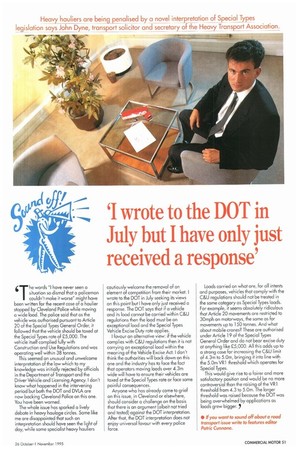'I wrote to the DOT in July but I have only just received a response'
Page 53

If you've noticed an error in this article please click here to report it so we can fix it.
6 he words "I have never seen a
situation so dismal that a policeman couldn't make it worse" might have been written for the recent case of a haulier stopped by Cleveland Police while moving a wide load. The police said that as the vehicle was authorised pursuant to Article 20 of the Special Types General Order, it followed that the vehicle should be taxed at the Special Types rate of 25,000. The vehicle itself complied fully with Construction and Use Regulations and was operating well within 38 tonnes. This seemed an unusual and unwelcome interpretation of the law which to my knowledge was initially rejected by officials in the Department of Transport and the Driver Vehicle and Licensing Agency. I don't know what happened in the intervening period but both the DOT and DVLA are now backing Cleveland Police on this one. You have been warned.
The whole issue has sparked a lively debate in heavy haulage circles. Some like me are disappointed that such an interpretation should have seen the light of day, while some specialist heavy hauliers cautiously welcome the removal of an element of competition from their market. I wrote to the DOT in July seeking its views on this point butt have only just received a response. The DOT says that if a vehicle and its load cannot be carried within C&U regulations then the load must be an exceptional load and the Special Types Vehicle Excise Duty rate applies. I favour an alternative view: if the vehicle complies with C&U regulations then it is not carrying an exceptional load within the meaning of the vehicle Excise Act. I don't think the authorities will back down on this one and the industry has to face the fact that operators moving loads over 4.3m wide will have to ensure their vehicles are taxed at the Special Types rate or face some painful consequences. Anyone who has already come to grief on this issue, in Cleveland or elsewhere, should consider a challenge on the basis that there is an argument (albeit not tried and tested) against the DOT interpretation. After that, the DOT interpretation does not enjoy universal favour with every police force.
Loads carried on what are, for all intents and purposes, vehicles that comply with the C&U regulations should not be treated in the same category as Special Types loads. For example, it seems absolutely ridiculous that Article 20 movements are restricted to 30mph on motorways, the some as for movements up to 150 tonnes. And what about mobile cranes? These are authorised under Article 19 of the Special Types General Order and do not bear excise duty at anything like £5,000. All this adds up to a strong case for increasing the C&U limit of 4.3m to 5.0m, bringing it into line with the 5.0m VR1 threshold which operates for Special Types.
This would give rise to a fairer and more satisfactory position and would be no more controversial than the raising of the VR1 threshold from 4.3 to 5.0m. The larger threshold was raised because the DOT was being overwhelmed by applications as loads grew bigger.
• If you want to sound off about a road transport issue write to features editor Patric Cunnane.












































































































































